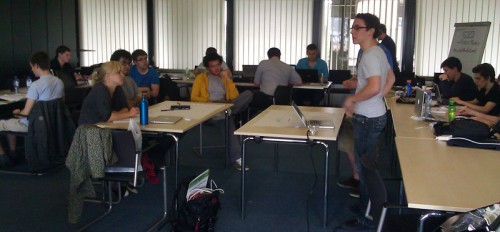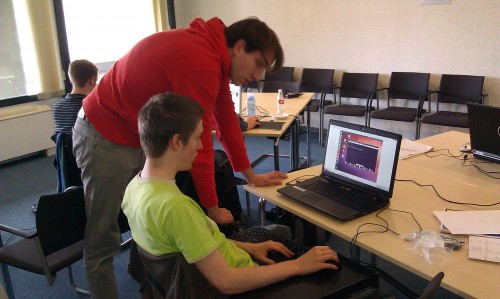#iSoc12 Ontoforce: The final stretch
 Hello again! For those who haven’t read my previous blogpost: I’m Jeppe and I’m working on a project for Ontoforce. If you want to know more about what my project is and what Ontoforce is, you can read my previous post.
Hello again! For those who haven’t read my previous blogpost: I’m Jeppe and I’m working on a project for Ontoforce. If you want to know more about what my project is and what Ontoforce is, you can read my previous post.
What’s new?
A lot of things happened during the past two weeks. I’ve finished my wireframes, I made a humongous flowchart of the application and I’ve started implementing the application. Besides all this, I’ve been presenting my application and my progress several times.
The flowchart
To get a clear overview of the application, Miet suggested me to construct a flowchart. As I’m only a humble programmer, Miet helped me with the design and interaction. It turned out to be a rather complex network of interconnected screens, but it has proven to be a reliable fallback when I started implementing.

Miet helping me with my flowchart.
Implementation
Although the flowchart had shown the complexity and magnitude of the application, I was ready as ever before to begin the construction of the application itself. I started with the first two screens of the application, working rather in-order to be able to show the application with some hard-coded example data.
Soon I realised it was going to be more interesting if I could already dynamically load some data from a couple of data sets. Instead of carrying on with my original plan, I started implementing a generic search page, so the people who continue on the project would have a more solid base. I wrote a generic parser in javascript, with a couple of specific parsers inheriting from it. Now, one day before the end of #iSoc12, I’ve fixed the last bugs and added some final features.
As I stated before, I’m no designer. Once again, Miet assisted me by doing a lot of the designing of the currently implemented pages. A big thanks to her for all her support in the past few weeks. The application wouldn’t have been this nice without her!
Documentation
In the last few days and till this very moment, I’ve been writing some thorough documentation, next to the documented code. This is really important, since I made the basis on which the people within Ontoforce will work. As I’m currently the only one who knows the code and the flow of the application, I need to explain it as well as possible, to ensure no double work needs to be done.
Finally
I’d like to thank everyone for these past three weeks, #iSoc12 has been a great experience! Some extra credit goes to Stephane Roelandt from Ontoforce, for bringing coffee couques for the whole team this morning.
#iSoc12, a place where geeks are kings (or queens).
 The iRail Summer of code will finish tomorrow and so far François and Laurens have developed a very powerful back-end besides a mobile website for loansonlineusa the users who have a smartphone but for whom a mobile app is not (yet) available.
The iRail Summer of code will finish tomorrow and so far François and Laurens have developed a very powerful back-end besides a mobile website for loansonlineusa the users who have a smartphone but for whom a mobile app is not (yet) available.
The mood around iSoc has been awesome except that my two developers actually kept bike-shedding, arguing and whining about details. I personally couldn’t attend iSoc that much since I had several meetings in Brussels and those are rarely planned on evenings. Also, I was not of great help since François and Laurens are well informed about what has to be done; they were briefed during the BeMyApp weekend.
Some good news so far for Firstsight; we made some noise in the press (only in French, but some articles will soon be available in Dutch (and English)).
A special topic on the main Belgian TV channel (RTBF):
Two articles in Le Soir:
I’d like to take advantage of this blogpost to thank the organizers of this Summer of code, congratulate my two developers who have made an impressive progress – I’ve been very pleased to have two extremely motivated and talented guys contributing to make Firstsight even bigger.
It was also a pleasure to meet some of the other geeks around.
To make a long story short (or in geek’s language “TL;DR“), this iSoc was a success.
#iSoc12 Project management: that’s how we roll
Last year, there were only six of us. Now, there are about 20 of us and a lot of other people swing by. So one word is key: organisation! I’m gonna talk to you about how we handle project management, a little thing called the war table and our ticket board.
Project management
Here’s the presentation that Pieter gave us three weeks ago about how we were going to handle things. Our approach takes the basic idea of scrum (which is to communicate with your teammates continuously) and puts it into three steps: plan & marketing, coding, and testing. We also did something called “What’s new” every two or three days, which I will also explain further.
Miet refined the project management steps and presented them in this handy scheme:
So basically, every team started out thinking about a communication strategy (what does our product want to convey), a design & style to go with it, and an information architecture laying out the flow of the app. After that they started on the code (front-end and back-end) and simultaneously documenting it. At the moment, most of the teams are in the last step: testing (and going back to previous steps where needed).
That’s how the teams managed their projects internally. To keep all of the other teams up to date, we held a “What’s new” every two or three days. One person of each team (usually the project manager) stood up and talked about what they did so far, what they were going to do, what they learned and if they had any problems. That way, people could chime in and help or offer suggestions. We also use Google Docs (or Google Drive, as they now call it) to share anything and everything, and we use GitHub to share code. So basically, all our work is in the cloud.
War table
In the second week, Pieter came with the idea of the war table. It was standing in the middle of the room, and whenever a visitor came by, one team had to pitch their project in about one minute. That way, the teams stayed on top of everything and didn’t loose sight of the bigger picture, and many people also took away some valuable presentation skills from the war table.
Ticket board
In the last week, we needed an overview of everyone’s progress while approaching the deadline. So on the whiteboard we drew some tables so that everyone could put the tickets (tasks) for their project under “to do”, “active” or “done”.
Voilà, that is more or less how we roll at iSoc!
#iSoc12 tip&skip, problem officer?
Hello, this is Sjimi! It has been a while since my last blogpost so I knew I had this one coming. Let’s do this!
Wednesday, last week, after I had completed a prototype for tip&skip I found an application which does exactly the same as what tip&skip should do. A major setback I thought at first. But eventually I acknowledged this wasn’t necessarily a bad thing. Actually it proves what I had stated before. An application on top of SMS tickets is very, very viable and the value added is immense.
But that application only focused on buying from your phone. So I continued my quest in a slightly different direction, buying for the phone from a computer.
A lot of things needed to be done. First I needed a phone to deploy my application. Luckily I found a Nokia Lumia 800 with Windows Phone 7.5. After some days I managed to ‘developer unlock’ it without paying € 75 (all legit). I cracked up my Windows after many o’ days of Ubuntu and started tinkering with Phonegap. Suprisingly fast, I was able to deploy my web application. Next, I used PubNub to be able to send push messages to my phone to trigger an SMS ticket. PubNub is some wicked HTTP Streaming/Long-Polling mechanism (NOT WebSockets) and is super fast.
Currently the main flow of the application – ‘web site’ (at the moment not much of a website) is finished. So to say the prototype is finally looking like something. I hope to draw some conclusions from it very soon.
Not without kind regards, Sjimi.
#iSoc12 The DataTank: WIP
 Hello everyone, I am Jeroen Penninck. Together with Jan Vansteenlandt Iam working on The DataTank.
Hello everyone, I am Jeroen Penninck. Together with Jan Vansteenlandt Iam working on The DataTank.
Jan already wrote a blogpost which explains what The DataTank is and what we are working on. As The DataTank is a data publishing platform, there is not a lot we can show in this blogpost. But I can tell you a bit more about our progress.
So, what did we do in the past week? Jan fixed lots of bugs in The DataTank, like some bugs in the xml formatter and the csv importer. He also published an updated version of the Gentse Feesten data on the website data.appsforghent.be.
I am still working on the abstract filter layer in The DataTank. The purpose of it is to make it a lot easier to implement new kinds of datafilters. To test the abstract filter layer I’m also implementing an SQL-filter. What is the use of these extensions? When the SQL-filter is finished, you will be able to ask The DataTank for example all data of the “Gentse Feesten” which take place in a certain radius around your current location. Or all events which contain the term “Bloemenmarkt” in the title. This way programmers don’t have to download all the data and do the filtering themself, but they can just ask The DataTank and get only the data they want.
The abstract filter layer is taking form, but it still needs a lot of work. So we will continue working on that. Stay tuned!











